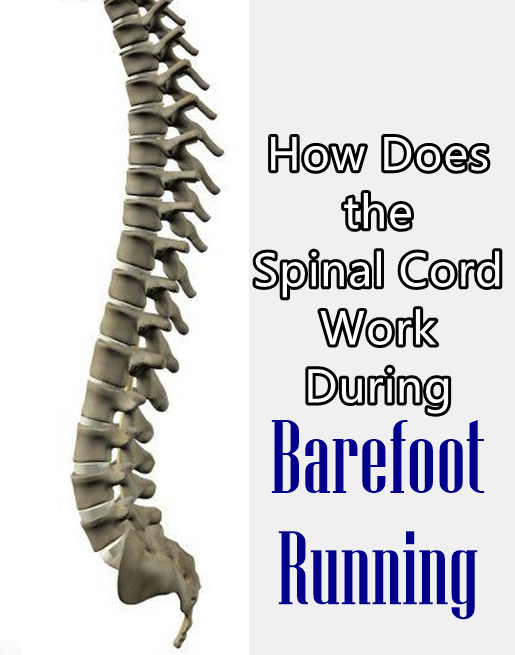Running should be a simple activity that does not require higher-order thinking. Most of our ability to run comes from the nervous system spinal cord –at least when we run barefoot.
Evidently, habitually barefoot runners –those who grew up running barefoot — tend to run with their minds on ‘autopilot’ because spinal cord function coordinates leg movements and foot strike pattern induced by tactile stimulation on the bare foot from the ground.
Nervous System Spinal Cord Function During Barefoot Running
So, knowing how the spinal cord works in barefoot running is very important because barefoot runners have unusually low injury rates compared to habitually shod runners. Therefore, the processing of movement-related sensory feedback in the spinal cord during barefoot running might at least partly be responsible for the reduced risk of getting injured.
So exactly how does the spinal cord work in terms of guiding leg movements during barefoot running?
Central Pattern Generators Control How We Run When Barefoot
The spinal cord contains central pattern generators which generate stable, ongoing, rhythmic motor patterns by application of a stimulus input to the bare foot (Fuchs et al. 2012). In the case of barefoot running, the strong proprioceptive feedback elicits the right amount of retraction/protraction ratios of the leg needed to produce light footfalls.
- The stimulus input to the bare foot results in specific gait characteristics, such as a forefoot strike and increased knee flexion, that can be accounted for the low impact nature of barefoot running. (Click here to learn how knee flexion allows barefoot runners to run safer)
Why is running barefoot so imperative to performance and injury prevention? Because the central coordination pattern within the spinal cord is proprioceptive-dependent and blocking or reducing proprioception with a cushioned running shoe raises the risk of motor pattern variability, inducing mechanical movements that are impulsive and unnatural (Fuchs et al. 2012). This is why barefoot running needs more attention in the running community.
Spinal Cord Doesn’t Like Underfoot Cushioning!
It’s well-known that after the invention of the modern running shoe, injury rates risen dramatically, which indicates that shoe cushioning mechanically imposes movements that are irregular and unintended (i.e. forced, not free) because central internal coordination of the spinal cord becomes compromised.
The Take Home Message
The responsiveness of the spinal cord to movement-related input during running relies solely on the availability of proprioception, which is consistent with past research on the effects of removal of proprioception on gait variability in runners.
- Reducing proprioception with underfoot cushioning evokes incessant mechanical errors that give rise to the most common running injuries.
Again, this is why it is important for shod runners to integrate barefoot running into their training program to intensify rhythmic motor patterns generated in the spinal cord, thereby preventing forceful stepping movements.
Dont want to go barefoot? Find out the kind of running shoes you can wear without compromising proprioception.
More From Run Forefoot:
- Running Barefoot vs Vibram FiveFingers
- 2 Ways to Stop Achilles Tendon Pain
- Where to Look When Running
- Less Heel Cushioning Means Better Running Economy
References:
Fuchs et al. Proprioceptive feedback reinforces centrally generated stepping patterns in the cockroach. J Exp Bio, 2012; 215:1884-1891.
Bretta Riches
BSc Neurobiology; MSc Biomechanics candidate, ultra minimalist runner & founder of RunForefoot. I was a heel striker, always injured. I was inspired by the great Tirunesh Dibaba to try forefoot running. Now, I'm injury free. This is why I launched Run Forefoot, to advocate the health & performance benefits of forefoot running and to raise awareness on the dangers of heel striking, because the world needs to know.
Latest posts by Bretta Riches (see all)
- Cushioned Running Shoes Found to Be Bad for Ankles - 23/04/2024
- Forefoot Running and Achilles Pain - 19/04/2024
- Does Foot Strike Really Matter in Running? YES! - 17/04/2024


Leave a Reply